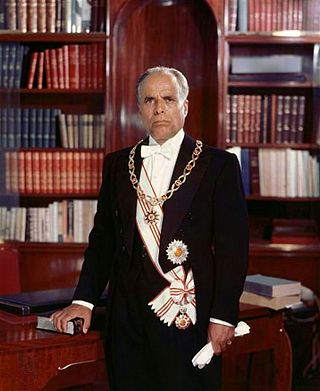
Habib Bourguiba was a Tunisian lawyer, nationalist leader and statesman who led the country from 1956 to 1957 as the prime minister of the Kingdom of Tunisia (1956–1957) then as the first president of Tunisia (1957–1987). Prior to his presidency, he led the nation to independence from France, ending the 75-year-old protectorate and earning the title of "Supreme Combatant".

Tunisian culture is a product of more than three thousand years of history and an important multi-ethnic influx. Ancient Tunisia was a major civilization crossing through history; different cultures, civilizations and multiple successive dynasties contributed to the culture of the country over centuries with varying degrees of influence. Among these cultures were the Carthaginian – their native civilization, Roman, Vandal, Jewish, Christian, Arab, Islamic, Turkish, and French, in addition to native Amazigh. This unique mixture of cultures made Tunisia, with its strategic geographical location in the Mediterranean, the core of several civilizations of Mare Nostrum.

Monastir, also called Mestir, is a city on the central coast of Tunisia, in the Sahel area, some 20 kilometres south of Sousse and 162 kilometres south of Tunis. Traditionally a fishing port, Monastir is now a major tourist resort. Its population is about 93,306. It is the capital of Monastir Governorate.

Muhammad VII al-Munsif, commonly known as Moncef Bey was the Bey of Tunis between 19 June 1942 and 14 May 1943. He was the penultimate ruler of the Husainid dynasty.

Menzel Bourguiba, formerly known as Ferryville, is a town located in the extreme north of Tunisia, about 60 kilometres (37 mi) from Tunis, in the Bizerte Governorate.

Mohammed Mzali was a Tunisian politician who served as prime minister between 1980 and 1986.

Beji Caid Essebsi served as the fifth president of Tunisia from 31 December 2014 until his death on 25 July 2019. Previously, he served as minister of foreign affairs from 1981 to 1986 and prime minister from February to December 2011.
Since the December 2010 revolution in Tunisia and protests across the Middle East and North Africa (MENA) began, Tunisian women have played an unprecedented part in the protests. Habib Bourguiba began instituting secular freedoms for women in 1956, such as access to higher education, the right to file for divorce, and certain job opportunities. Women in Tunisia enjoy certain freedoms and rights that are denied to women in neighboring countries, although the social norms have shifted since 2011.

The Kingdom of Tunisia was a short-lived country established as a monarchy on 20 March 1956 after Tunisian independence and the end of the French protectorate period. It lasted for a period of one year and five months between 20 March 1956, the day of the independence, until 25 July 1957, the day of the declaration of the republic. Its sole monarch, titled Bey of Tunis, was Muhammad VIII al-Amin who appointed the prime ministers Tahar Ben Ammar and Habib Bourguiba.
The Tunisian national movement was a sociopolitical movement, born at the beginning of the 20th century, which led to the fight against the French protectorate of Tunisia and gained Tunisian independence in 1956. Inspired by the ideology of the Young Turks and Tunisian political reforms in the latter half of the 19th century, the group of traditionalists—lawyers, doctors and journalists—gradually gave way to a well-structured political organisation of the new French-educated elite. The organisation could mobilise supporters to confront the authorities of the protectorate in order to advance the demands that it made of the French government. The movement's strategy alternated between negotiations and armed confrontations over the years. Support from the powerful trade unions and the feminist movement, along with an intellectual and musical cultural revival, contributed to a strong assertion of national identity which was reinforced by the educational and political systems after independence.
The Turks in Tunisia, also known as Turco-Tunisians and Tunisian Turks, are ethnic Turks who constitute one of the minority groups in Tunisia.

Taïeb Mhiri was a Tunisian politician.

Mezri Haddad is a Tunisian journalist, writer, philosopher and diplomat. Haddad was a doctor of moral and political philosophy at the Paris-Sorbonne University, and the first Muslim candidate to be qualified by the National Council of French universities as a lecturer in Catholic theology. He is the author of several essays that focus on politics and religion.
The 1987 Tunisian coup d'état involved the bloodless ousting of the aging President of Tunisia Habib Bourguiba on 7 November 1987, and his replacement as President by his recently appointed Prime Minister, Zine El Abidine Ben Ali. The action was justified by reference to Bourguiba's failing health and Article 57 of the country's constitution. Reports later surfaced to indicate that the Italian intelligence services had been involved in planning it.

The haik is a traditional women's garment worn in Algeria. It can be white or black, though is usually white. It consists of a rectangular fabric covering the whole body, 6 by 2.2 metres in length, rolled up then held at the waist by a belt and then brought back to the shoulders to be fixed by fibulae.

Bahri Guiga was a Tunisian lawyer and politician.
The Habib Bourguiba bibliography includes major books about President Habib Bourguiba of Tunisia, his biography, presidency and policies.
Dorra Bouzid was a Tunisian journalist, art critic, and feminist.
The Tunisian Association of Democratic Women is a Tunisian feminist association which was founded in 1989.

Sophie Bessis is a Tunisian-born French historian, journalist, researcher, and feminist author. She has written numerous works in French, Spanish, and English on development in the Maghreb and the Arab world, as well as the situation of women denouncing the identity imprisonment to which they are subjected. She is the recipient of the Paris Liège literary prize and was honored as Commandeur of the Order of the Republic.













